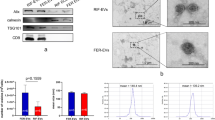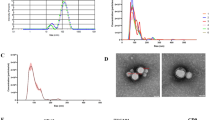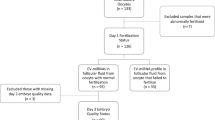Abstract
Uterine fluid (UF) extracellular vesicle (EV) miRNA may affect implantation and could be the potential biomarker of endometrial receptivity (ER). Ovarian stimulation (OS) could damage the ER but its mechanism is still unclear. Here, we evaluate the affections of OS on UF EV miRNA expression and implantation. Female rats were divided into three groups: natural cycle or injection with GnRH-a following HP-HMG or u-FSH. UF was collected on the 5th day of gestation. Affinity membrane columns were utilized to isolate EVs from UF, obtained during implantation flushing. The EV miRNAs were sequenced, and five of them were validated by qRT-PCR. HTR-8/Svneo cells were transfected with miR-223-3p mimic and inhibitor, followed by conducting colony formation, invasion, migration, and adhesion assays to assess the cellular functions. In OS groups, the implantation rate decreased (p < 0.05), and the pinopode was damaged in the OS groups. The EVs were isolated from UF, and the differential expression key miRNAs were involved in several regulation pathways, such as cancer, endocrine, and cell cycles, which were correlated with ER and implantation. Among the miRNAs, miR-223-5p greatly differed and was most consistent with the sequencing results, followed by miR-223-3p and miR-98-5P. miR-223-3p promoted HTR-8/SVneo cells grow and ability of invasion, migration, and adhesion. OS altered UF EVs miRNAs affecting implantation in rats, and miR-223-3p might be the key molecule.





Similar content being viewed by others
Data Availability
The original data presented in the study are included in the article/supplementary material. Further inquiries can be directed to the corresponding authors.
Abbreviations
- ART:
-
Artificial reproduction technology
- ER:
-
Endometrial receptivity
- WOI:
-
Window of implantation
- OS:
-
Ovarian stimulation
- UF:
-
Uterine fluid
- EV:
-
Extracellular vesicles
- MV:
-
Microvesicles
- SD rat:
-
Sprague–Dawley rat
- TEM:
-
Transmission electron microscopy
- DLS:
-
Dynamic light scattering
- qRT-PCR:
-
Quantitative reverse transcription–polymerase chain reaction
- GnRH-a:
-
Gonadotropin-releasing hormone agonist
- HP-hMG:
-
High-purity human menopausal gonadotropin
- U-FSH:
-
Urine follicle stimulation hormone
References
Psychoyos A. Uterine receptivity for nidation. Ann NY Acad Sci. 1986;476:36–42.
Troncoso C, Bosch E, Rubio C, Remohí J, Simón C, Pellicer A. The origin of biochemical pregnancies: lessons learned from preimplantation genetic diagnosis. Fertil Steril. 2003;79:449–50.
Chen C, Yan Q, Liu K, Zhou X, Xian Y, Liang D, et al. Endometrial receptivity markers in mice stimulated with raloxifene versus clomiphene citrate and natural cycles. Reprod Sci. 2016;23:748–55.
Zapantis G, Szmyga MJ, Rybak EA, Meier UT. Premature formation of nucleolar channel systems indicates advanced endometrial maturation following controlled ovarian hyperstimulation. Hum Reprod. 2013;28:3292–300.
Wu JL, Keller P, Kanchwala M, Xing C, Babayev SN, Carr BR, et al. Controlled ovarian stimulation protocols alter endometrial histomorphology and gene expression profiles. Reprod Sci. 2020;27:895–904.
Zhang Y, Wang Q, Wang H, Duan E. Uterine fluid in pregnancy: a biological and clinical outlook. Trends Mol Med. 2017;23:604–14.
Griffiths GS, Galileo DS, Reese K, Martin-DeLeon PA. Investigating the role of murine epididymosomes and uterosomes in GPI-linked protein transfer to sperm using SPAM1 as a model. Mol Reprod Dev. 2008;75:1627–36.
Pan BT, Teng K, Wu C, Adam M, Johnstone RM. Electron microscopic evidence for externalization of the transferrin receptor in vesicular form in sheep reticulocytes. J Cell Biol. 1985;101:942–8.
Capalbo A, Ubaldi FM, Cimadomo D, Noli L, Khalaf Y, Farcomeni A, et al. MicroRNAs in spent blastocyst culture medium are derived from trophectoderm cells and can be explored for human embryo reproductive competence assessment. Fertil Steril. 2016;105:225-235.e3.
Fereshteh Z, Bathala P, Galileo DS, Martin-DeLeon PA. Detection of extracellular vesicles in the mouse vaginal fluid: their delivery of sperm proteins that stimulate capacitation and modulate fertility. J Cell Physiol. 2019;234:12745–56.
Homer H, Rice GE, Salomon C. Review: Embryo- and endometrium-derived exosomes and their potential role in assisted reproductive treatments–liquid biopsies for endometrial receptivity. Placenta. 2017;54:89–94.
Vojtech L, Woo S, Hughes S, Levy C, Ballweber L, Sauteraud RP, et al. Exosomes in human semen carry a distinctive repertoire of small non-coding RNAs with potential regulatory functions. Nucleic Acids Res. 2014;42:7290–304.
Hong L, Zang X, Hu Q, He Y, Xu Z, Xie Y, et al. Uterine luminal-derived extracellular vesicles: potential nanomaterials to improve embryo implantation. J Nanobiotechnol. 2023;21:79.
Abou-Kheir W, Barrak J, Hadadeh O, Daoud G. HTR-8/SVneo cell line contains a mixed population of cells. Placenta. 2017;50:1–7.
Nishida M. The Ishikawa cells from birth to the present. Hum Cell. 2002;15:104–17.
Thie M, Denker H-W. In vitro studies on endometrial adhesiveness for trophoblast: cellular dynamics in uterine epithelial cells. CTO. 2002;172:237–52.
Occhipinti G, Giulietti M, Principato G, Piva F. The choice of endogenous controls in exosomal microRNA assessments from biofluids. Tumor Biol. 2016;37(9):11657–65.
Livak KJ, Schmittgen TD. Analysis of relative gene expression data using real-time quantitative PCR and the 2−ΔΔCT Method. Methods. 2001;25:402–8.
Nikas G, Aghajanova L. Endometrial pinopodes: some more understanding on human implantation? Reprod Biomed Online. 2002;4:18–23.
Hsu C-Y, Hsieh T-H, Tsai C-F, Tsai H-P, Chen H-S, Chang Y, et al. miRNA-199a-5p regulates VEGFA in endometrial mesenchymal stem cells and contributes to the pathogenesis of endometriosis: miRNA99a-5p in endometriosis. J Pathol. 2014;232:330–43.
Huang K, Dong X, Sui C, Hu D, Xiong T, Liao S, et al. MiR-223 suppresses endometrial carcinoma cells proliferation by targeting IGF-1R. Am J Transl Res. 2014;6:841–9.
Wang M, Ji S, Shao G, Zhang J, Zhao K, Wang Z, et al. Effect of exosome biomarkers for diagnosis and prognosis of breast cancer patients. Clin Transl Oncol. 2018;20:906–11.
Xia H-F, Jin X-H, Cao Z-F, Shi T, Ma X. MiR-98 is involved in rat embryo implantation by targeting Bcl-xl. FEBS Lett. 2014;588:574–83.
Théry C, Witwer KW, Aikawa E, Alcaraz MJ, Anderson JD, Andriantsitohaina R, et al. Minimal information for studies of extracellular vesicles 2018 (MISEV2018): a position statement of the International Society for Extracellular Vesicles and update of the MISEV2014 guidelines. J Extracell Vesicles. 2018;7(1):1535750. Available from: https://www.ncbi.nlm.nih.gov/pmc/articles/PMC6322352/. Cited 2020 Nov 15.
Burns G, Brooks K, Wildung M, Navakanitworakul R, Christenson LK, Spencer TE. Extracellular vesicles in luminal fluid of the ovine uterus. Ye X, editor. PLoS One. 2014;9:e90913.
Chen Q, Zhang Y, Elad D, Jaffa AJ, Cao Y, Ye X, et al. Navigating the site for embryo implantation: biomechanical and molecular regulation of intrauterine embryo distribution. Mol Aspects Med. 2013;34:1024–42.
Machtinger R, Laurent LC, Baccarelli AA. Extracellular vesicles: roles in gamete maturation, fertilization and embryo implantation. Hum Reprod Update. 2016;22:182–93.
Syn NL, Wang L, Chow EK-H, Lim CT, Goh B-C. Exosomes in cancer nanomedicine and immunotherapy: prospects and challenges. Trends Biotechnol. 2017;35:665–76.
Cretoiu D, Xu J, Xiao J, Suciu N, Cretoiu SM. Circulating microRNAs as potential molecular biomarkers in pathophysiological evolution of pregnancy. Dis Markers. 2016;2016:3851054.
Shekibi M, Heng S, Nie G. MicroRNAs in the regulation of endometrial receptivity for embryo implantation. Int J Mol Sci. 2022;23:6210.
Liang J, Wang S, Wang Z. Role of microRNAs in embryo implantation. Reprod Biol Endocrinol. 2017;15:90.
Altmäe S, Martinez-Conejero JA, Esteban FJ, Ruiz-Alonso M, Stavreus-Evers A, Horcajadas JA, et al. MicroRNAs miR-30b, miR-30d, and miR-494 regulate human endometrial receptivity. Reprod Sci. 2013;20:308–17.
Cuman C, Van Sinderen M, Gantier MP, Rainczuk K, Sorby K, Rombauts L, et al. Human blastocyst secreted microRNA regulate endometrial epithelial cell adhesion. EBioMedicine. 2015;2:1528–35.
Kropp J, Salih SM, Khatib H. Expression of microRNAs in bovine and human pre-implantation embryo culture media. Front Genet. 2014;5:91.
Mirkin S, Nikas G, Hsiu J-G, Díaz J, Oehninger S. Gene expression profiles and structural/functional features of the peri-implantation endometrium in natural and gonadotropin-stimulated cycles. J Clin Endocrinol Metab. 2004;89:5742–52.
Ng YH, Rome S, Jalabert A, Forterre A, Singh H, Hincks CL, et al. Endometrial exosomes/microvesicles in the uterine microenvironment: a new paradigm for embryo-endometrial cross talk at implantation. Ward WS, editor. PLoS One. 2013;8:e58502.
Kusama K, Nakamura K, Bai R, Nagaoka K, Sakurai T, Imakawa K. Intrauterine exosomes are required for bovine conceptus implantation. Biochem Biophys Res Commun. 2018;495:1370–5.
Ararooti T, Niasari-Naslaji A, Asadi-Moghaddam B, Razavi K, Panahi F. Superovulatory response following FSH, eCG-FSH and hMG and pregnancy rates following transfer of hatched blastocyst embryos with different diameter and shape in dromedary camel. Theriogenology. 2018;106:149–56.
Moro F, Scarinci E, Palla C, Romani F, Familiari A, Tropea A, et al. Highly purified hMG versus recombinant FSH plus recombinant LH in intrauterine insemination cycles in women ≥35 years: a RCT. Hum Reprod. 2015;30:179–85.
Tabata C, Fujiwara T, Sugawa M, Noma M, Onoue H, Kusumi M, et al. Comparison of FSH and hMG on ovarian stimulation outcome with a GnRH antagonist protocol in younger and advanced reproductive age women. Reprod Med Biol. 2015;14:5–9.
Haneklaus M, Gerlic M, O’Neill LAJ, Masters SL. miR-223: infection, inflammation and cancer. J Intern Med. 2013;274:215–26.
Dominguez F, Moreno-Moya JM, Lozoya T, Romero A, Martínez S, Monterde M, et al. Embryonic miRNA profiles of normal and ectopic pregnancies. PLoS One. 2014;9:e102185.
Li C, Chen L, Zhao Y, Chen S, Fu L, Jiang Y, et al. Altered expression of miRNAs in the uterus from a letrozole-induced rat PCOS model. Gene. 2017;598:20–6.
Dong X, Sui C, Huang K, Wang L, Hu D, Xiong T, et al. MicroRNA-223–3p suppresses leukemia inhibitory factor expression and pinopodes formation during embryo implantation in mice. Am J Transl Res. 2016;8(2):1155–63.
Shariati MBH, Niknafs B, Seghinsara AM, Shokrzadeh N, Alivand MR. Administration of dexamethasone disrupts endometrial receptivity by alteration of expression of miRNA 223, 200a, LIF, Muc1, SGK1, and ENaC via the ERK1/2-mTOR pathway. J Cell Physiol. 2019;234:19629–39.
Piersanti RL, Horlock AD, Block J, Santos JEP, Sheldon IM, Bromfield JJ. Persistent effects on bovine granulosa cell transcriptome after resolution of uterine disease. Reproduction. 2019;158:35–46.
Zhu H-Y, Ge T-X, Pan Y-B, Zhang S-Y. Advanced role of Hippo signaling in endometrial fibrosis: implications for intrauterine adhesion. Chin Med J (Engl). 2017;130:2732–7.
Sansores-Garcia L, Atkins M, Moya IM, Shahmoradgoli M, Tao C, Mills GB, et al. Mask is required for the activity of the Hippo pathway effector Yki/YAP. Curr Biol. 2013;23:229–35.
Acknowledgements
The authors appreciate the technical expertise of the team led by Professor Wu of the Lab of Biomedical Electronic Microscopy Higher Research Center, Central South University, Central South University. We would also like to thank everyone in the Reproductive Medicine Center, Xiangya Hospital, Central South University, Changsha, Hunan, People’s Republic of China, for their kind help and encouragement.
Author information
Authors and Affiliations
Contributions
Y.L. was involved in study concept and supervised the project. X. H. was involved in study design, performing all experiments, data analysis, and writing manuscript. L. X. was involved in experiments. J. Z., Q. Z., and Y. W. provided experiments guide and revised manuscript and figures. All the authors listed have approved the manuscript that is enclosed and agreed to the order of authors.
Corresponding author
Ethics declarations
Ethical Approval
All experiments were approved by the Institutional Animal Care and Use Committee of Central South University (animal ethics number: 2020sydw0136) and were conducted in accordance with the National Institute for Health Guide for Care and Use of Laboratory Animal.
Conflict of Interest
The authors declare no competing interests.
Additional information
Publisher's Note
Springer Nature remains neutral with regard to jurisdictional claims in published maps and institutional affiliations.
Supplementary Information
Below is the link to the electronic supplementary material.
Rights and permissions
Springer Nature or its licensor (e.g. a society or other partner) holds exclusive rights to this article under a publishing agreement with the author(s) or other rightsholder(s); author self-archiving of the accepted manuscript version of this article is solely governed by the terms of such publishing agreement and applicable law.
About this article
Cite this article
Huang, X., Zhao, J., Zhang, Q. et al. Ovarian Stimulation Altered Uterine Fluid Extracellular Vesicles miRNA Affecting Implantation in Rats. Reprod. Sci. (2024). https://doi.org/10.1007/s43032-023-01448-w
Received:
Accepted:
Published:
DOI: https://doi.org/10.1007/s43032-023-01448-w




